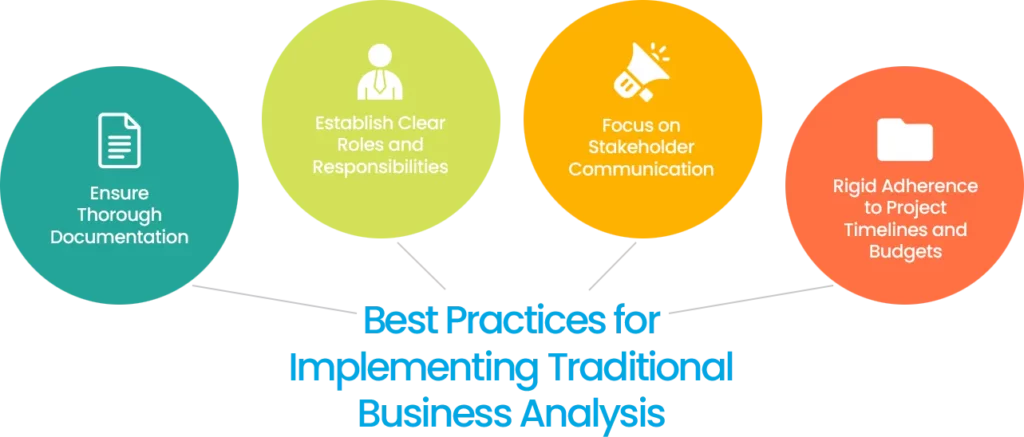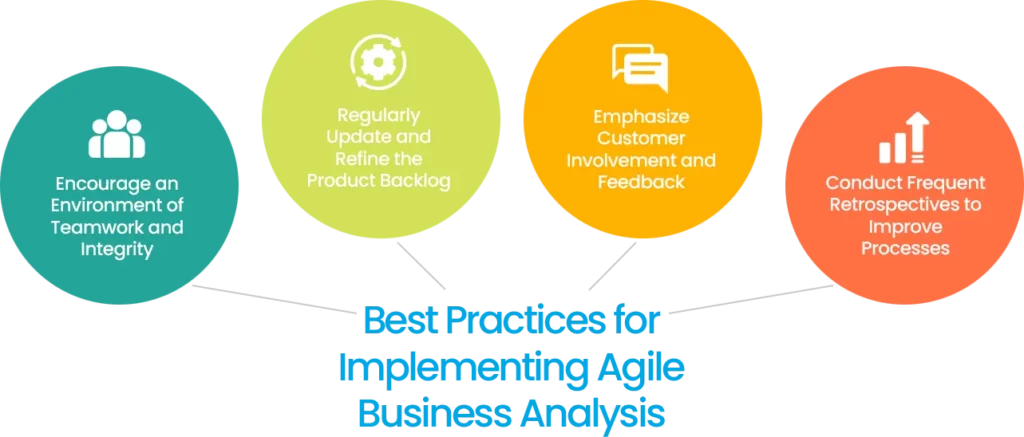Business analysis is essential to the success of the project as it is the link between stakeholders and the project team. Business analysis is dominated by two main methodologies: traditional and agile business analysis. Each has its unique strengths, weaknesses, and best use cases.
After reading the blog, you will learn about the core principles, advantages, drawbacks, and best practices of each methodology. It will give a deep analysis to assist you in selecting the most appropriate course of action for your projects.
What is Traditional Business Analysis?
Traditional business analysis, often referred to as Waterfall methodology, is a structured, document-centric approach that follows a linear project lifecycle. It emphasizes detailed planning, comprehensive documentation, and a sequential process.
Core Principles of Traditional Business Analysis?

Core principles often revolve around thorough documentation, detailed requirements gathering, and a sequential project lifecycle. Core principles include:
- Comprehensive Documentation: Detailed documentation of requirements, processes, and business rules is essential.
- Requirement Elicitation: Detailed gathering and examination of stakeholder needs to define precise and comprehensive requirements.
- Process Modeling: Creating visual representations of business processes to understand workflows and identify improvement areas.
- Data Analysis: Investigating information to identify patterns, trends, and insights for informed decision-making.
- Solution Design: Creating comprehensive system or solution specifications that satisfy business requirements.
- Change Management: Planning and carrying out tactics to control the effects of system or process changes.
Traditional business analysis involves distinct phases. Each phase must be completed before the next begins, ensuring a structured and predictable process. The project phases of traditional business analysis provide a structured framework for applying these core principles. Let’s break down how they interrelate:
- Initiation: Establishing the project’s goals and scope requires a solid understanding of the fundamentals of data analysis and requirement elicitation.
- Planning: To create a complete project plan, thorough documentation, process modeling, and solution design are necessary.
- Execution: All core principles are applied during execution, as requirements are implemented, processes are refined, and data is monitored.
- Monitoring and Control: To monitor development and make any corrections, data analysis, and change management are essential.
- Closure: To complete the project and guarantee a smooth transition, thorough documentation and change management are essential.
Advantages of Traditional Business Analysis

- Comprehensive Documentation: Detailed documentation provides a clear and comprehensive record of requirements, processes, and decisions, ensuring transparency and accountability.
- Thorough Planning: The upfront planning phase allows for a detailed understanding of project scope, resources, and timelines, reducing risks and uncertainties.
- Predictability: The linear form of the process provides a clear roadmap and makes project durations and deliverables more predictable.
- Risk Mitigation: Early in the project lifecycle, with a focus on upfront planning, possible risks can be identified and addressed.
- Clear Roles and Responsibilities: Defined project phases and roles contribute to a clear understanding of responsibilities and accountability.
- Suitable for Large-scale Projects: Traditional business analysis is often well-suited for large-scale projects with complex requirements.
- Established Methodology: The approach is widely understood and accepted, making it easier to find skilled resources.
Drawbacks of Traditional Business Analysis
- Inflexibility: Traditional methods are inflexible and sequential, which makes it hard to adapt to shifting market conditions or requirements. This can result in project delays and cost overruns.
- Late Feedback Incorporation: Since feedback is often gathered at the end of phases, there’s a risk of building the wrong product or service, resulting in rework and increased costs.
- Siloed Team Structure: Functional silos can hinder collaboration and communication, leading to inefficiencies and delays in decision-making.
What is Agile Business Analysis?
Agile business analysis is an iterative and incremental approach. It emphasizes flexibility, collaboration, and continuous feedback, making it ideal for projects with evolving requirements.
Core Principles of Agile Business Analysis?

The core principles of Agile analysis are centered around collaboration, flexibility, and delivering value. They are:
- Customer Focus: Recognizing and ranking the needs of the customer to provide the most value.
- Collaboration: Working closely with development teams, stakeholders, and other business analysts to achieve shared goals.
- Continuous Improvement: Continuously looking for methods to improve results and procedures.
- Flexibility: Adapting to changing requirements and market conditions.
- Value Delivery: Focusing on delivering business value quickly and incrementally.
- Inspection and Adaptation: Assessing development regularly and making required corrections.
Advantages of Agile Business Analysis

- Rapid Adaptation: Agile allows for swift adjustments to evolving requirements and market dynamics.
- Continuous Delivery: Regular product increments ensure consistent value delivery and stakeholder satisfaction.
- Strong Collaboration: Teams that span functional boundaries facilitate efficient communication and prompt decision-making.
- Customer Centricity: Agile assists in producing goods that genuinely connect with the market by putting the demands of the client first.
- Enhanced Quality: Frequent testing and feedback loops lead to higher-quality outcomes.
- Risk Mitigation: Early identification and response to risks through iterative development.
- Improved Stakeholder Satisfaction: Regular involvement and value delivery enhance stakeholder engagement.
- Increased Efficiency: Focus on delivering value incrementally and optimizes resource utilization.
- Empowered Teams: Self-organizing teams drive innovation and problem-solving.
Drawbacks of Agile Business Analysis
- Reduced Predictability: Agile’s iterative nature can make it challenging to accurately forecast project timelines, costs, and scope.
- Dependency on Strong Teamwork: Effective Agile implementation requires high levels of collaboration and communication among team members.
- Documentation Challenges: The focus on delivering working software may result in less comprehensive documentation compared to traditional methods.
Key Differences Between Traditional and Agile Business Analysis
|
Feature |
Traditional |
Agile |
|
1. Approach to Planning |
Detailed upfront |
High-level initial planning |
|
2. Requirements Gathering |
Detailed upfront |
Continuous refinement |
|
3. Project Lifecycle |
Distinct phases |
Iterative cycles (sprints) |
|
4. Flexibility and Adaptability |
Low |
High |
|
5. Focus |
Comprehensive planning and documentation |
Delivering value early and often |
|
6. Stakeholder Involvement |
Limited |
Continuous |
|
7. Team Structure |
Hierarchical |
Self-organizing |
|
8. Risk Management |
Predictive |
Proactive |
|
9. Role of Business Analyst |
Requirements document |
Collaborator and problem-solver |
|
10. Delivery |
The final product at the end |
Working increments |
Best Practices for Implementing Traditional Business Analysis

Ensure Thorough Documentation
In traditional business analysis, thorough documentation is crucial. It guarantees that all parties involved have a common knowledge of the project requirements and aids in maintaining clarity.
Establish Clear Roles and Responsibilities
To prevent confusion and ensure accountability, clearly define roles and responsibilities. This increases productivity and simplifies procedures.
Focus on Stakeholder Communication
Effective communication with stakeholders is critical. Regular updates and progress reports help manage expectations and keep everyone aligned.
Rigid Adherence to Project Timelines and Budgets
Strictly adhering to the predefined timelines and budgets ensures predictability and helps avoid scope creep and cost overruns.
Best Practices for Implementing Agile Business Analysis

Encourage an Environment of Teamwork and Integrity
Encourage open communication and collaboration within the team and with stakeholders. This enhances understanding and ensures that everyone is aligned with the project goals.
Regularly Update and Refine the Product Backlog
The product backlog should be a living document regularly updated and refined based on stakeholder feedback and changing requirements.
Emphasize Customer Involvement and Feedback
Customer involvement is key in Agile. Regular feedback helps ensure that the project is on the right track and meets customer expectations.
Conduct Frequent Retrospectives to Improve Processes
Frequent retrospectives allow the team to reflect on their performance and identify areas for improvement. This helps enhance efficiency and effectiveness over time.
Choosing the Right Methodology (Factors to Consider)
Project Complexity and Requirements Volatility
If your project has well-defined requirements and a clear understanding of the desired outcome, traditional methodologies might be more appropriate. On the other hand, Agile is better suited for projects with evolving or uncertain requirements.
Team Size and Composition
Due to its emphasis on collaboration and adaptability, agile often performs best in smaller, cross-functional groups. For projects with complex dependencies and substantial documentation requirements, traditional approaches could be simpler to oversee for larger teams with specialized roles.
Customer Involvement and Collaboration Needs
Agile emphasizes ongoing customer collaboration which makes it ideal for projects where customers need to be closely engaged throughout. If customer involvement is minimal, traditional methodologies might be more suitable.
Budget Constraints and Resource Availability
Traditional methodologies can be useful for projects where budgets and resource allocations need to be tightly controlled. Agile requires flexibility in budget and resource allocation to accommodate changing requirements.
Project Timeline and Delivery Urgency
Smaller to medium-sized projects with shorter timeframes typically work best with agile, which emphasizes early and continuous delivery. For more complicated, longer-term projects with well-defined milestones, traditional methods may be more appropriate.To learn more about Business Analysis, enroll in our course Salesforce Business Analyst.
Hybrid Approach
Sometimes, your needs won’t be best served by either a completely Agile or entirely traditional approach. It may work well to take a hybrid approach that incorporates aspects of both. For example, you could use Agile for software development and traditional methodologies for regulatory compliance. With this strategy, you may make use of the advantages of both approaches to suit the particular requirements of your project.
Case Studies
Bank of America
Bank of America an American multinational investment bank, is an excellent example of a business that has combined an agile approach with the complexity of a traditional industry. As a financial institution, it has a long history of structured processes, detailed documentation, and risk mitigation—hallmarks of traditional business analysis. This method protects client data and guarantees adherence to strict rules.
However, the banking industry is undergoing rapid digital transformation. To stay competitive, Bank of America has adopted agile principles for certain projects. For instance, in developing mobile banking applications or enhancing customer experiences, the bank likely employs agile methods to accelerate development, increase customer satisfaction, and adapt to changing market trends.
Therefore, Bank of America’s business analysis approach can be characterized as a hybrid model, combining the rigor of traditional methods for core banking operations with the flexibility and speed of agile for digital initiatives.
Walmart
Walmart an American multinational retail corporation, is an example of a company that has successfully integrated both traditional and agile business analysis techniques to drive its operations. For this retail organization to handle its basic operations, inventories, and financial planning, traditional business analysis is essential. Stability, effectiveness, and conformity to established protocols are guaranteed by this method.
However, Walmart has also embraced agile principles to respond to the dynamic retail landscape. The company’s e-commerce platform, omnichannel initiatives, and customer-centric strategies necessitate a more flexible and iterative approach. Agile allows Walmart to adapt quickly to changing customer preferences, market trends, and technological advancements.
In essence, Walmart’s business analysis function is a hybrid model that leverages the strengths of both traditional and agile methodologies to optimize its operations and maintain a competitive edge.
Conclusion
Choosing the right business analysis methodology is very important to the success of any project. Both traditional and agile business analysis have advantages and disadvantages, and the optimal option will rely on the particular requirements and restrictions of your project.
Making an informed decision that supports the objectives of your project is possible if you are aware of the key differences, and best practices associated with each approach. Continuously evaluating and adapting your chosen methodology will further enhance your ability to deliver successful projects.










